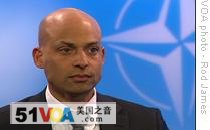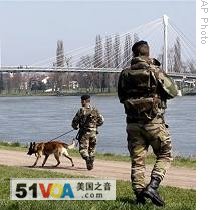Brussels
30 March 2009
Founded in the aftermath of World War II and at the onset of the Cold War, the North Atlantic Treaty Organization bound together western European countries, Canada and the United States to safeguard each other's security against the rising threat of the Soviet Union. Much has changed - the Soviet Union is no more, and NATO has expanded eastward.
![[insert caption here] [insert caption here]](https://img.51voa.cn/images/200903/NATO_1.jpg) |
The North Atlantic Treaty Organization has about 60,000 troops under its command in Afghanistan and more are on the way.
NATO leaders to discuss Afghanistan
AT NATO headquarters in Brussels, spokesman James Appathurai says Afghanistan tops the agenda at the alliance's 60th anniversary summit.
 |
| James Appathurai |
NATO leaders insist progress is being made in Afghanistan, but they acknowledge more work lies ahead.
In the Horn of Africa, off Somalia, NATO maintains a small fleet that guards against pirates.
Appathurai points out NATO has airlifted African Union peacekeeping troops into Somalia.
"It is part of the evolution of the organization to deal with security threats that we would never have dreamed of addressing 20 years ago," added Appathurai.
NATO was founded in April 1949 - with a dozen member states. The alliance bound together countries of Western Europe with the United States and Canada.
Its mission: to counter the growing threat from the Soviet Union and protect against attack from Moscow or its allies in the Warsaw Pact.
A security analyst at London's International Institute for Strategic Studies, Dana Allin, says this is something NATO did very well.
"Its largest success obviously was hanging together, maintaining a credible deterrent posture and keeping the West together without having to go to war and that was a huge success," said Allin.
NATO redefines mission
But the fall of the Soviet Union raised questions about what new purpose NATO might serve.
 |
| French soldiers walk along the bridge between France and Germany that will host official picture of forthcoming NATO meeting, 30 Mar 2009 |
The early 1990's challenged NATO's traditional defensive stance. Yugoslavia began to pull apart at the seams, disintegrating into civil war, ethnic cleansing and genocide. Then came Kosovo.
"NATO was slow, the West in general was slow, to react to this. But when it did, it did so effectively," added Dana Allin.
The NATO campaign in Kosovo forced Serb forces to end their bloody campaign against Kosovo's ethnic Albanians. Following that mission came new operations and a new strategic balance in Europe. After the fall of the Soviet Union, NATO expanded eastward, taking in new members from Poland to the Baltic Republics and the Balkans, moving right up to the Russian border. Still more are waiting to join.
Russia has objected vehemently to this expansion and to plans by the United States to place a missile-defense shield in parts of Eastern Europe.
Future brings new responsibilities
Amid such unresolved issues, NATO continues looking to the future, says Spokesman Apparthurai.
"What do we need to do, should we do more to fight cyber attacks, should we do more to engage in energy security, how far should NATO's reach be for operations, who should our partners be and how should we engage with them," he said.
So, should NATO go global? Security analyst, Dana Allin urges caution. He says - use NATO when it makes sense.
"It is an organization that brings a lot of countries to the table, that is the most logical place for force generation when the West wants to do something that involves military forces. That is already a lot. It is not necessary to make it [NATO] fit every crisis," he said.
New missions for the 21st Century - it has been a catch-phrase at NATO headquarters and among its 26 member states. In short, "what should this 60-year old alliance do to make sure it remains relevant?"